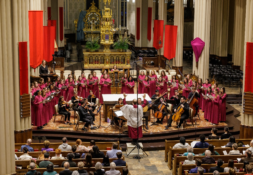Oscar winner’s striking ending delivers meaningful message
The mere existence of La La Land is nothing short of what we loosely call a miracle. Moreover, the dimensions of the miracle are enhanced by the wide praise the movie has received from both critics and the public. I shall not justify these sweeping statements here; they have already been sufficiently justified elsewhere, not least by a review in this newspaper. I want to focus instead on the movie’s final scene to try to make a point that, as far as I know, has not been made. In the unlikely event that you have not seen La La Land: beware, because I am about to spoil it for you, as I proceed to tell you how the movie finishes. Though, truth be told, La La Land is insusceptible of spoiling: such is the nature of its inherent beauty that one could see it time and again.
There are, I think, three possible assessments of the film’s finale. I shall call the first one “romantic,” and while I expound upon it, I will deprive the unlikely reader of this article who has not yet watched La La Land of the movie’s greatest surprising turn. In the long coda, Mia (Emma Stone), now an established actress, happily married to some handsome guy, and the mother of a cute daughter, enters a random bar with said husband—where she happens to find Seb (Ryan Gosling), five years after their last meeting. Her former boyfriend has, at last, managed to make his dream, running a joint where jazz reigns supreme, come true. After rapturously listening to Seb play a song on the piano for the audience, when asked by her husband whether she would like to stay for a little longer, Mia declines and they prepare to leave. At this exact moment Mia and Seb look into each other’s eyes; she smiles but holds to her initial decision: to leave and, presumably, to go on with her career and her present family.
The romantic viewer is really sorry that Mia does not go back to Seb, with whom she had parted ways some time ago under circumstances we ignore. The romantic’s reason is, unsurprisingly, romantic: Seb had been Mia’s “true love,” and surely he still is. Mia had been Seb’s “true love” and, the romantic insists, she still is. This interpreter will certainly keep in mind the last words that the protagonists of the story had exchanged five years prior, the last time we saw them talking to each other, immediately before Mia’s audition that would forever change her (and his) life. “I’m always gonna love you,” Mia had proclaimed, and Seb had assented.
The second assessment is the one of my teenage niece, and I will call it “realistic.” When I asked my 16-year-old niece whether she thought that La La Land’s finale was a bit sad (sad, I will add now, from the romantic’s perspective), she commented: “Whether sad or not, the end of the movie is a bath of reality: that is how things are in the real world.” I would venture to add that this is so partly because of a currently typical tendency to prioritize career over and above romance, or even love—an attitude some people attribute to “millennials” like my niece. In his review for the New York Times, A. O. Scott wrote that “the drive for professional success is, for young people at the present time, both more realistic and more romantic than the pursuit of boy-meets-girl happily-ever-after.” Although Mr. Scott certainly could not have intended it, his is an apt summary of my niece’s take.
Finally, the third evaluation, which I will call “mine.” In the world in which we live, the finale of La La Land is as good as it gets; and in that sense it is highly commendable from a Christian, indeed a moral, point of view. The sadness (highlighted by the romantic evaluation) is only the result of a preexisting, different sadness in the lives of Seb and Mia: their not having been sufficiently committed to their mutual happiness so as to give themselves to each other forever—what is, or was, typically called “marriage.” Instead, she moves in with him in the typical Hollywood fashion, not long after they have fallen in love. No discussion whatsoever of an everlasting commitment; no engagement; of course (or perhaps subsequently), no marriage in sight. Why then ought one to be surprised if life places these extremely attractive birds apart when, later down the road, the wind blows from new, unforeseen directions?
If Mia was going to love Seb always (and vice versa) it would have been fitting that they married (or thought about marriage) earlier. Once they did not (why they did not does not really matter, but it is not difficult to guess that the moral climate of our society happens to be a contributing factor in such cases), their apparent decision in the final scene to stick to the current status quo presents itself as sound and prudent. Mia is now happily married, and falling back for Seb would entail destroying that unique type of commitment which earlier she had not been willing or prepared to undertake.
So, I heartily welcome La La Land, and not despite its unhappy ending. The movie’s finale is a wonderful opportunity for us to notice that what is already beautiful can be even more so if love is carried to its last consequences sooner rather than later.
Santiago Legarre is a professor of law at Universidad Católica Argentina and a visiting professor at Notre Dame Law School.






Leave a Reply